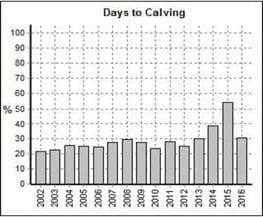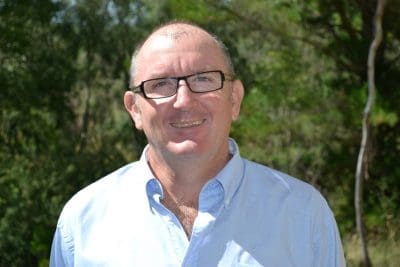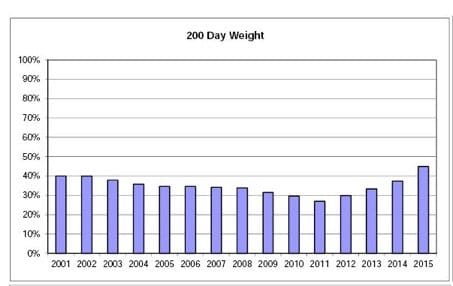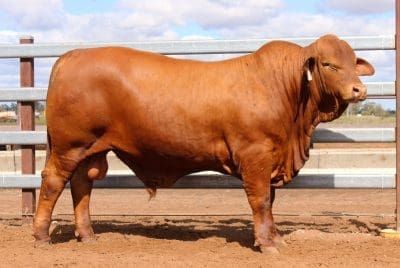AUSTRALIA’S beef cattle industry is in two distinct camps when it comes to the science of objective genetic selection through Breedplan.
It would be easy to generalise and say the southern industry uses Breedplan and the northern industry does not. But a growing number of tropical breeds are embracing Breedplan recording, with Brahmans leading the way.
 The breed’s annual showcase event, the Rockhampton Brahman Week Sale, this year on October 3 to 5, this year includes 40 percent of the catalogue of 890 sale bulls with BreedPlan figures. That reflects the 54pc of registered Brahman females that had joining dates submitted in 2015 (see graph). The 2016 figure is expected to better than 2015 by year’s end.
The breed’s annual showcase event, the Rockhampton Brahman Week Sale, this year on October 3 to 5, this year includes 40 percent of the catalogue of 890 sale bulls with BreedPlan figures. That reflects the 54pc of registered Brahman females that had joining dates submitted in 2015 (see graph). The 2016 figure is expected to better than 2015 by year’s end.
The 2016 Brahman Week event will be the last for long-serving Australian Brahman Breeders Association general manager John Croaker who is retiring at the end of the year. The ABBA is advertising for a replacement.
The growth in BreedPlan recording in the north has not been accidental. In part, uptake has been accelerated by the Agricultural Business Research Institute (ABRI) and Meat & Livestock Australia appointing a Rockhampton-based Tropical Beef Technology Services (TBTS) representative.
TBTS and its sister organisation, Southern Beef Technology Services (SBTS), are charged with the task of providing members of breed societies with technical support enabling them to maximise the use and understanding and use of a range of genetic technologies such as Breedplan, BreedObject selection indices and DNA-based technologies.

Paul Williams
Providing the TBTS service in Queensland is veteran technical officer Paul Williams, who had a 22-year stint with CSIRO and between 1996 and 2011, was with the Beef CRC in Rockhampton where he was responsible for research projects focusing on beef production in northern Australia.
Mr Williams believes there is positive change happening in objective measurement.
Back in 2001 just on 40pc of the total registered cattle in the five major tropical breeds (Brahman, Santa Gertrudis, Droughtmaster, Brangus and Braford) had 200-day weights recorded.

A combination of the live export crisis and drought created a steady decline over the next decade to a low point of under 30pc in 2011. Since then, there has been a regular strong annual increase and last year the number had grown to 45pc (see graph above).
But it is not easy when industry-leading studs don’t use BreedPlan. The reasons are varied with the main one being the vastness of properties in the north which inhibits the collection of data to generates accurate genetic analysis.

Karragarra Marcus, sold for $80,000 at this week’s Droughtmaster National, with no BreedPlan data
The Droughtmaster National in Rockhampton last week resulted in 436 bulls averaging $9596 with a top of $80,000 paid for Karragarra Marcus – a magnificent looking bull (see photo) but carrying no Breedplan figures.
At that sale, Karragarra and Medway each sold 11 bulls and each averaged over $18,000. Not one Breedplan EBV among those studs’ 22 bulls.
Angus goes all the way
In other parts of the continent, Angus bulls are shunned if they do not carry Breedplan figures.
Andrew Byrne, formerly with SBTS and now breed development and extension manager with Angus Australia, said there were currently more than 650 Angus Australia members enrolled in Angus Breedplan, and a staggering 96pc of animals recorded with Angus Australia with a birth date between 2011-15 are analysed in Angus BreedPlan.
Record numbers of performance measurements are being collected on Angus animals in Australia and BreedPlan analysis now includes more than 960,000 birth weights, one million weaning weights, 500,000 live animal ultrasound scanning measurements and 220,000 scrotal circumference measurements, he said.
The Angus breed now claims to lead the industry with the adoption of genomics technology, with genomic information now included in Angus Breedplan for more than 16,000 animals.
Analysis of the performance information collected on Angus seedstock animals demonstrates the genetic merit of Angus bulls is now, on average, more than $80 per cow mated more profitable than the equivalent Angus bulls in 1990.

Andrew Byrne
That genetic improvement has been achieved by Angus animals being 63kg heavier live weight at 20 months of age, and having carcases that are 41kg heavier at 25 months, 0.6pc higher yielding with 1.6pc more intramuscular fat (in a 400kg dressed weight carcase).
Mr Byrne said the economic value of the accumulated genetic gains in the Angus-influenced segment of the Australia beef industry during this time have been estimated to be more than $2.5 billion, with additional improvements in profitability in Angus beef operations.
But he also admits these gains have been assisted through changes in management and production practices.
Bull sale highlights from the past week
The past week of spring bulls sales action has kept agents busy, with 23 sales in four states. Highlights included:
- The Droughtmaster National in Rockhampton where 436 bulls sold in a 98pc clearance to average $9596 with a top of $80,000. That’s a huge step-up from last year, when 401 bulls averaged $6817 in an 86pc clearance.
- The Braford National also in Rockhampton where 137 bulls averaged $7390.
- It meant that in three days of selling at Rockhampton’s CQLX at Gracemere, 573 tropical breed bulls (Droughtmaster and Braford) grossed $5.2 million.
- Long established Hereford stud Devon Court averaged $9100 in their section of the Southern Cross sale at Jackson, Qld this past week. The average more than doubled last year’s and was more than the 2015 top price.
- Santa Gertrudis continued their stellar run this year with Greenup Eidsvold Station averaging $9250 for 104 bulls.
- The Grove Shorthorns sold 127 bulls at an average of $8425 with a top of $58,000 paid by Weebollabolla. The Munro family from Weebollabolla themselves later in the week sold 93 bulls at an average $7411.
- Down in Tasmania, Landfall Angus had a spring sale which averaged $7355 for 90 bulls, the top Tasmanian average for the year.
Rain forces postponement for Dangarfield
Local flooding forced the postponement of this week’s Dangarfield Santa Gertrudis sale at Taroom, Qld. A new date is yet to be set. Contact GDL’s Harvey Weyman-Jones on 0414 941 788 for updates.



Phil Holmes, you are a gem. But you have overlooked another telling visual trait I learned from watching the judging at a country show in Queensland’s north.
The judge, complete with RM Uniform and large belt buckle observed that the champion sire had a hump with a rear slope of about 60 degrees.
Just perfect!!! Champion of the Show!!
Stand by for some more upcoming comment from Phil Holmes on cattle genetics, Rod. Editor
I have to confess a rushed effort in getting into this important debate. My time is short, but I considered the issue serious enough to contribute. We have a Breed Society board meeting tonight where some of the most important agenda items of the year come up for discussion. Board members will be putting forward a motion to change the colour of the coats and the hat size of the bull leaders at future major shows . This is a critical issue for our breed society as almost one hundred years of tradition are on the line and it is in our charter to maintain historical standards. Standards may change around us but it is up to us to decide if that change will benefit our breed.
There will be another important motion calling for the accreditation of hoof trimming contractors. Standards have lapsed of late and we cannot afford to let the bulls of our breed into shows without the best possible feet.
There was some push coming from those fringe, measurement based people on changes to how certain of those EBV things that they keep banging on about may be refined for our breed, but frankly, I doubt it will make the agenda.
We have had requests from 14 new High Schools to set up programs for the students to get involved in the beef industry. I think this request for funding will get up tonight as it is so important for the future of young Australians wanting to pursue a career in Agriculture. They need help immediately on the design of a breed colored shirt, inclusive of their high school logo. The bone colored moleskins and RMs are a given thank goodness. We have a comprehensive program in place on feeding, flossing, foot trimming and fussing to get them into the judge’s eyes. At all cost, we have to keep them out of the reaches of those measurement fanatics. All they talk about is bloody figures. It costs our Society a fortune to supply them and for what? Well prepared bulls, allowed to express their full potential sell as well, or even better than those measured bulls, which are, frankly, a disgrace to the breed. For God’s sake, they have not even been taught how to lead.
I am looking forward to the Board meeting tonight. We have invited Australia’s pre-eminent show Judge to give a presentation on how to appraise a ‘Good Sirey Outlook’, ‘Standing Well Over The Ground’, and ‘Good Spring of Rib’, essential traits in a good bull.
We don’t need these irrelevant EBV’s to describe bulls and have a successful business. All that is needed is to feed and prepare them to fulfill their genetic potential and let the experienced and discerning buyers decide.
I see the future of the beef industry in the hands of people like us who hold to traditional standards. It is coming increasingly apparent to us that it is all about the head and that is now our focus. Get the head shape right and you have a good bull. Some of the new show judges coming through have almost reached genius status in appraising this trait.
I am fairly confident that those pestering EBV people will not have the numbers tonight to cause much concern, Must go, there is a special on a bulk buy of Coat-Glo, a new product promising extra sheen on the coats of bulls.
This ‘debate’ about the usefulness or otherwise of objective measurement of bulls and bovine genetics is completely nonsensical. I’m afraid my sympathies and interest lie with the traditional non-measurement brigade as their product is unique and has serious all-encompassing advantages. I understand the immense satisfaction that comes from allowing a bull to reach its full potential. You can start by fostering it onto a milking cow soon after birth to maximise growth to weaning. Then start to supplementary feed it to maintain the quest for expression of true merit. Along the way, groom it, shampoo it and teach it to lead, maybe with a little foot trimming and selective coat clipping; at the end, it could slip into most herds.. While all this is happening, it’s sire can be doing the show circuit and collecting Champion ribbons for the critically important traits such as ‘Standing Well Over His Ground’, ‘Good Spring of Rib’, ‘Good Sirey Outlook’ and ‘Thick Through The Twist’ through the eyes of an expert judge skilled in appraising these traits. These judges spend years on the circuit learning how to appraise these critical traits and deserve respect.
Sons and daughters can be encouraged to attend a High School that maintains an ‘Agricultural’ curriculum which maintains the standards and keeps science out. The new student team turns up every year in their prescribed School logo shirt, bone moleskins and RM’s. They fuss, feed, floss and fret without any perspective on the irrelevance of what they are doing. Its easy pickings for my mob because the science teachers generally have no idea of the implications and associations of what is happening and the road ahead, My mob are 80% of the way there. The whole agricultural education system at school level is set up to think about gloss and fluff. That crazy measurement mob cannot afford to give away that head start. They are doomed if my mob can get to the kids and show them, at least with cattle, it is all about gloss, fluff, moleskins and RM’s
On sale day, the masses turn up and are prepared to spend a fortune on fat and fluff with absolutely no idea if the bull is going to increase their business performance or not (the statistical chances are only 1 in 4 that he will be without objective measurement). The only rational conclusion that can be reached is that commercial producers who buy bulls in this system have just won Lotto or are seriously wealthy off-farm. Obviously they have above above average business skills and understand issues that drive profitable commercial beef production that elude the objective measurement mob.
This is the ultimate business model. Provide a product with absolutely no performance specifications, polish it and fluff it up and lead it into a sale ring of eager buyers.
We should go to Boeing with the model as a serious business proposal. No more aeronautical engineers and complex physics, just polish and gloss. Yep, the non-measurement mob have got it nailed. Perhaps their business model may be forced to change if commercial beef producers had the same attitude to buying a bull as they do to purchasing an flight ticket. I have no sympathy for the measurement mob because I cannot understand their pursuit of beef herd profitablity on the basis of rational, evidence based decisions. Let them live or die on their approach; they are just a nuisance on the sidelines of the true beef world.. In the meantime, I have to duck into town for some more coat shampoo and be back before the hoof trimmer arrives.
And, God forbid, the Breed Society have just decided that at the next show, the colour of the coat worn by the bull leaders for our breed has to change and the hat size has to increase. The important issues are never ending at the pointy end of the beef world, unlike that measurement mob who just wallow in the misery of looking at figeres.
There is no doubt that bulls with out genetic data can perform well for some traits that are easy to visualise and measure but with the increasing prices being paid for bulls at the moment, it really is a “no brainer” to ensure that the product in which you are investing is accompanied by as much quantitative data that you can obtain before making that investment. The question that needs to be asked is not whether or not to buy a bull with Breedplan data but “Have I got confidence in the product I am purchasing?” Would you buy a new vehicle without having a road worthy certificate or knowing that it has the both the power and economy that you need in your operation? Traits such as ‘days to calving”, calving ease, birth weights, carcase traits etc are impossible to assess in the flesh in a sire prepared for the sale ring. One of the important research findings from the Beef CRCIII was that if you want to breed cows that have improved chances of getting back in calf as soon as possible after calving, then select bulls from cows that got back into calf within 3 months of calving as a maiden heifer or that have good Days to Calving EBV’s. Half of the genes in the progeny are derived from the dam and as the female progeny of the bull you purchase today will remain in your breeding herd for up to 12-15 years, Breedplan data is a very valuable tool to give you the reassurance you are making the right decisions now.